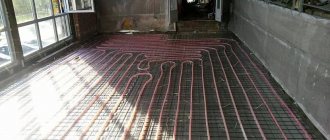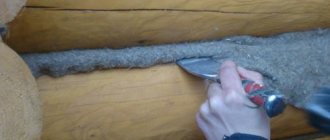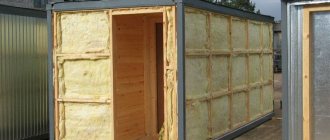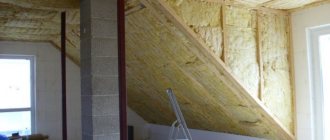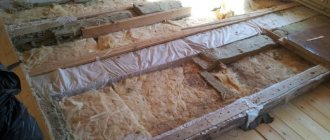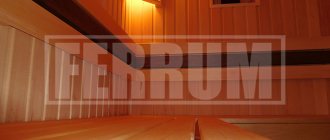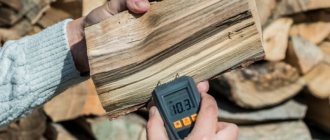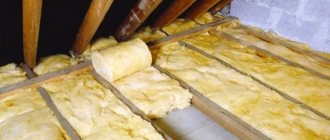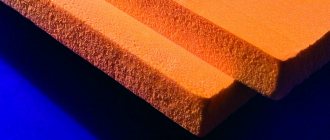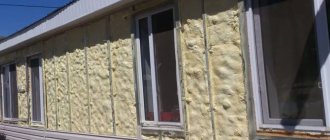The main function of the Russian bath is to strengthen human health. To achieve this goal and in no way harm your body while visiting the bathhouse, you must properly insulate the bathhouse. If all the rules for insulating this type of room are followed, the heat in the bathhouse is retained for a long time, which significantly saves money spent on its heating.
The process of insulating walls in a bathhouse
In most cases, insulation must be done indoors. This allows you to quickly heat the bath and also quickly cool it if necessary. The bathhouse has the following properties:
- Relatively low air temperature 50-60 degrees;
- High humidity. Sometimes it can reach 100%.
Step-by-step internal insulation of a bathhouse
Mineral wool
The classic method of insulating the ceiling in a bathhouse is the use of mineral wool. There are three main types of mineral insulation: basalt, fiberglass and slag wool.
Basalt is produced in slabs of standard sizes or in rolls of standard width. Thicknesses typically used are 50 and 100 mm. Attention should be paid to the fact that the ceiling in the steam room is precisely the surface that is subject to extreme influences of temperature and humidity. The thickness of the insulation on the ceiling must be at least 150 mm. Experts recommend installing in three layers of 50 mm with overlapping joints. The density of the material is usually 35-40 kg/m3.
Important point! When using mineral insulation, it is laid directly on the rough ceiling, without using a vapor barrier between the heat insulator and the ceiling.
Basalt fiber has the following significant advantages:
- Excellent mechanical strength allows installation on surfaces of any configuration.
- High thermal insulation ability. The low coefficient of thermal conductivity contributes to maximum heat conservation in the room; the insulation also has high noise and sound insulation characteristics.
- Resistant to sudden temperature changes. Some manufacturers claim that their product can withstand up to 200 heating and cooling cycles.
- Immunity to the appearance of bacteria, fungi, mold. Basalt is not attractive to rodents and insects.
- The main advantage can be considered the fire safety of the material, which not only does not support combustion, but also, when heated, does not emit harmful fumes.
- Basalt-based slabs are easy to cut and install.
The disadvantages include:
- The relatively high cost of this type of mineral insulation, given the need to install a layer with a total thickness of 150 mm.
- When wet, mineral wool loses its beneficial properties, so it is important to use it only with vapor and waterproofing materials.
Fiberglass is also often used as insulation.
Material based on quartz fibers has the same technical characteristics as basalt material:
- Fiberglass, due to its fibrous structure, has a low thermal conductivity, which is 0.039-0.047 W/m K.
- The flammability group of many quartz-based products is NG, which means non-flammable. Some are marked with the G1 value, that is, they do not support combustion. At high temperatures, the fibers begin to sinter without releasing harmful substances.
- The moisture resistance of this material is slightly higher than that of basalt, however, the use of fiberglass in tandem with vapor and waterproofing is mandatory.
- Biological inertness does not allow fungus and mold to develop in the thickness of the insulation.
- The elasticity of the material allows it to withstand increased deformations, and after removing the load, return to the original geometric dimensions.
- Low cost.
Disadvantages of the material:
- Short service life.
- Installation should only be carried out in a protective suit and precautions must be taken, since small fiberglass fibers can irritate the skin and are very dangerous for the respiratory tract. In addition, it is recommended to install this heat insulator not from the steam room side, but from the attic side.
The main feature of the thermal insulation of a bathhouse is the use of a foil layer in the insulation “pie”. As a rule, to do this, foil is placed on the selected heat insulator, gluing the joints with aluminum tape. It is foil that is the material that provides the “thermos effect” in the steam room and reflects infrared heat from the stove into the room. It is especially important to pay attention to difficult-to-insulate components in the corners of the room, in the opening of a window or door. If you neglect the thoroughness of sizing, there is a high probability that there will be places through which steam will enter the insulation, which, in turn, will quickly become unusable.
Many mineral wool manufacturers offer the consumer specially designed products with a foil layer already applied. The benefits of such proposals are obvious - foil insulation performs the function of thermal insulation and vapor barrier at the same time, which is economically beneficial. This material has a high level of water resistance and thermal insulation, saving resources on heating the room.
Options for constructing steam room insulation for different steam rooms
First of all, you cannot use the same insulation laying scheme for a steam bath if the box is built from different materials. Simply put, you cannot stupidly copy the diagram for a frame steam room and transfer it to a brick or block bathhouse box. There are certain differences that need to be discussed in more detail.
Below is the correct scheme for insulating a frame steam room.
The main difference is that the thermal insulation layer of the steam room is actually divided into two separate layers, which are laid with overlapping seams. This allows you to block the possible occurrence of cold bridges. In addition, a ventilation gap must be installed in the thermal insulation of the frame steam room and a superdiffusion membrane must be installed. It passes condensed water vapor in one direction, from inside the room to outside.
For block and timber baths, you can use a simpler option. For example, for a steam room made of profiled timber, lay the insulation directly on the wall. Don't let the lack of a special ventilation duct bother you. Due to the inter-crown seams, hot water vapor will relatively easily escape from the space between the insulation and the timber wall of the steam room. Such schemes are actively used for baths attached or built into the premises of a private house.
This design already actively uses aluminum foil or polyethylene foam heat insulator with a reflective layer. Since the walls of the steam room are quite warm, there is no point in spending internal heat to carry the dew point as far as possible to the outer surface of the beam and block.
It is clear that for log and timber steam rooms it is necessary to pay attention to sealing and caulking the inter-crown joints, otherwise a large amount of moisture and humid air will get into the bathhouse through cracks and cracks.
In a similar way, you can build insulation in a steam room made of cinder block. In this case, the supporting beam of the sheathing can be laid horizontally. But this option is considered even more preferable, since there is no risk of rupture of the insulation layers during the shrinkage of the walls, as in the case of the crowns of a log or timber frame.
Slag
To produce slag wool, blast furnace slag is used as a raw material, which is previously processed into microfibers. During the production process, additives containing formaldehyde resins are added to cotton wool, which, as is known, release highly harmful substances when heated.
Among the advantages can be noted:
- Low cost.
- Resistance to rodents, fungus and mold.
- Easy installation
The disadvantages of slag wool do not allow its use for insulation in a bathhouse or sauna:
- Sudden temperature changes, which are typical for a steam room, lead to the product losing its thermal insulation qualities.
- The high hygroscopicity of the material will quickly lead to the loss of its function as a heat insulator.
- The increased fragility and thorniness of fibers dictates the presence of a protective mask and respirator when working.
- Slag wool is not able to withstand high loads and is deformed even under the influence of its own weight, sliding down over time if it is mounted in walls.
- Most importantly, slag wool contains phenol and formaldehyde in concentrations dangerous to humans, so using it indoors is extremely undesirable.
Laying thermal insulation materials
The installation process of the insulation layer can be divided into several stages.
Frame making
To install the insulation, a sheathing is first made. Wooden planks are attached to wall surfaces. When insulating a new log bathhouse, it is necessary to take into account an important point. During the first three years, the building shrinks by about 20 cm.
If the sheathing is nailed too tightly to the logs, then during shrinkage the walls may become deformed and cracks may form.
Therefore, before installation, special grooves are cut into the bars with a jigsaw, 15–20 cm long and 45–50 cm in increments. Then, when the bathhouse shrinks, the nail will slide along the slot and the integrity of the log house will not be compromised.
Installation of insulation
A layer of fiberglass is laid on the walls between the sheathing slats and proceed to laying the insulation. If you use mineral wool in a roll, then it is cut into the necessary fragments, which are placed in the cells of a wooden sheathing. The width of the insulation pieces should be slightly larger than the distance between the beams.
When the material expands, it will fill the space between the slats well. The insulation should adhere to the walls as tightly as possible. All resulting voids must be blown out with foam.
Expanded clay
Fine bulk material in the form of clayey porous stones. The manufacturing technology involves high-temperature firing of clay. Expanded clay granules can have different sizes, which affects the thermal insulation properties of the material. For a bath, it is better to use filler with smaller fractions.
Can be used as ceiling or floor insulation in a bathhouse. When insulating the ceiling, the layer of expanded clay will be 20-30 cm, which, for example, is justified if there is no attic in the bathhouse.
Let us note the main advantages of expanded clay:
- The product is environmentally friendly. Without toxic impurities.
- The low thermal conductivity of the material explains the high energy efficiency of thermal insulation.
- Frost-resistant material, able to withstand regular heating and cooling cycles.
- Does not attract mice and other rodents.
- Biologically resistant to mold and fungal colonies.
- The fire resistance of the material allows it to be used in potentially fire hazardous areas.
- Cheapness.
Serious disadvantages include:
- Fragility of expanded clay granules. Working with it is not as easy as it might seem at first glance. Damaged material granules lose their thermal insulation properties.
- High water absorption due to the porous structure of the fractions dictates the mandatory use of high-quality waterproofing.
How to insulate a concrete floor in a steam room
In the end, you should move on to insulating the floors in the steam room. In addition to thermal insulation, you should also take care of waterproofing the floors. There are two types of material installation algorithm. In this paragraph we will talk about floor insulation in a steam room with a concrete base.
The following algorithm for thermal and waterproofing is simplified, since it is used when laying under tiles.
The work is performed as follows:
- The base is leveled to a perfectly level state.
- Bituminous mastic is applied on top of it and wait for it to dry completely.
- Then roofing felt and polymer film are laid.
- Tiles are installed on top.
Better design for thermal insulation of concrete floor:
- A plywood sheet is mounted on the rough base.
- Waterproofing with a spade on the walls is laid on it.
- All joints are taped with aluminum tape.
- The gaps are sealed and insulated with a construction hair dryer.
- A reinforcing mesh is laid on the layer and filled with a layer of concrete mortar.
- After the screed has hardened, you can begin laying the tiles.
When pouring a concrete screed, it is important to take into account the age of the wood used to create the chopped bathhouse. It is important to use material that is at least 2 years old. Otherwise, shrinkage of the structure will occur, which will cause deformation or destruction of the foundation.
Styrofoam
A universal material of organic origin, it has found its application in many areas. However, in a bathhouse its use is limited to installation only in rooms that do not experience maximum temperature loads. Polystyrene foam or expanded polystyrene is good for insulating the walls of a bathhouse outside, ceilings and walls in a locker room or rest room. It can be used for attic floors or on the roof of a bathhouse.
The advantages include:
- Extremely resistant to damp environments. Polystyrene foam absorbs no more than 0.2% moisture per day.
- Durability. Foam plastic feels great for up to 20 years of use in severe conditions of temperature changes and more than 50 years in normal conditions.
- Low weight and easy installation.
- Does not support combustion. When exposed to an open flame, this product begins to melt.
- Immunity to microorganisms and mold.
- Low cost.
Flaws:
- The main drawback that makes it impossible to use it inside a bathhouse is the release of toxic phenol vapors during melting. Polystyrene foam loses chemical stability already at a temperature of 95 degrees.
- It is not recommended to use foam plastic indoors, since the high thermal insulation capacity of foam plastic will lead to a shift of the dew point inside the wall and the formation of condensation, which will inevitably lead to the rapid destruction of the insulating layer.
Ceiling insulation
Insulation of a steam room from the ceiling is carried out according to the instructions:
— preparation of the base;
- use of cotton wool;
— installation of breathable film.
On the ceiling, it is worth removing the outer covering and going through it with a jigsaw. If you have a power tool, it is easier to process large surfaces. Craftsmen try to remove paint and damaged material.
There may be burrs left somewhere, which will affect the adhesion of the materials. If paint or other finishing material cannot be removed, you should use special primers.
In the store you can find products with quartz. It is important to check with the manufacturer for which surfaces the product is suitable. Quartz is considered to be a universal material. After priming, it is worth considering the step-by-step instructions for insulation.
For example, cotton wool and film were chosen for the steam room. This means that sheathing will have to be installed on the surface. When a square room is considered, the design is allowed to be made along guides. In this case, the planks are laid diagonally.
For installation of a guide, metal corners up to 2 cm wide are suitable. However, this option is not suitable for rooms with low ceilings. It is important to understand that the cotton wool will take another 3 cm, plus the film is laid. Next, the exterior finishing is applied.
If you use plasterboard for the ceiling, it is better to immediately choose a high-quality sealant. Some people love foam with good adhesive properties. As an option, you can consider professional cylinders.
It is quite possible to fix the sheathing on the foam, but such work looks extremely rough. Plus, it’s worth remembering that you won’t get a smooth surface. As a result, the cotton wool will not be able to adhere tightly to the surface. Once the insulation is laid, you can begin to apply the film. This is the finishing layer before finishing.
For this purpose, staples that can be fixed manually are suitable. Special guns make the job easier. Ordinary or decorative plaster is used as a finishing finish. If practicality comes first, you can simply smooth the surface.
When you want to create something beautiful, you can try decorative options with paints. Craftsmen try to first check the parameters with the manufacturer. In particular, I am interested in the maximum temperature that a fake can maintain.
Next begins the installation, where you can show the skill of using the tools. Also, do not forget about available materials. For example, you are allowed to use stencils for the ceiling. The result is an abstract drawing that will not leave anyone indifferent.
Homemade options are also appreciated when tulle is used. If you apply it to a surface, the design will quickly be imprinted on the surface.
Penoizol
Penoizol is a foam insulation material that resembles liquid foam in appearance. It is applied according to the principle of working with polyurethane foam. The technology for applying penoizol to surfaces involves working only with frame systems. In liquid form, the material expands and fills the space between the guides. Hardening occurs after 10 minutes, and maximum strength is achieved after three days.
Pros of penoizol:
- Good thermal conductivity.
- Good sound insulation performance.
- Fire resistance. The material belongs to the G1 flammability class, that is, it does not burn and does not support combustion. When heated, it does not emit toxic substances.
- The material is elastic. With its help, you can insulate hard-to-reach places. The foam will fill all cracks and voids, eliminating the formation of cold air bridges.
- Strength. Cured foam has a low linear deformation rate.
- Not interesting to rodents and microorganisms.
The disadvantages include:
- The high percentage of water absorption calls into question the use of the material inside a bathhouse or sauna.
- The relatively high cost of application is due to the use of special equipment, which can only be provided by professional organizations.
Penoizol is not recommended to be applied as a heat insulator on surfaces in direct contact with the steam room in a bathhouse, since temperature cycles can reduce the physical properties of the insulator. It can be used to finish the floor or walls in adjacent rooms and on slopes inside the bathhouse in the attic.
Practical advice
Experienced craftsmen have formulated several tips for those who decide to insulate a steam room with their own hands:
- Window design. To reduce heat loss from windows, it is better to make them small and carefully insulate the opening and slopes. In addition, they need to be placed lower so that the hottest air does not touch them. At the same time, condensation on the glass will be reduced. Multi-chamber metal-plastic windows should be installed to reduce heat loss through the frame.
- The doorway should be low, with a high threshold. This will reduce the outflow of warm air through the upper part and the influx of cold air through the lower part of the opening.
- You should select the furnace power corresponding to the area of the steam room. It is also important to place a sufficient amount of stones in the heater. To speed up heating and increase heat transfer, stones are placed in special wire mesh around the chimney or firebox body.
A properly insulated steam room warms up quickly and retains heat for a long time. It is cozy and comfortable, fuel is consumed economically. If a home craftsman has the skills of general construction work and follows the recommendations given, he can easily insulate the steam room with his own hands.
Extruded polystyrene foam
A modern organic-based material consisting of air capsules and foamed polystyrene. This thermal insulator is popular for use in various rooms due to the combination of its properties:
- Waterproof material. Extrusion does not absorb moisture and does not lose its insulating properties in high humidity conditions.
- Resistant to temperature changes. The material does not lose its qualities in such conditions.
- High resistance to compressive loads (which is important when insulating floors).
- Extruded polystyrene foam is a durable material. Well-known brands promise a long service life of more than 50 years with the preservation of all characteristics, which is proven by tests with repeated freezing and thawing.
- Synthetic origin makes the material unsuitable for the development of mold and fungi.
- Light weight and easy installation.
There are far fewer disadvantages than advantages, however, their presence may call into question the choice of this type of insulation as a heat insulator for a bathhouse:
- Oddly enough, it is susceptible to attacks by rodents.
- Low resistance to fire. The material does not burn, but actively melts, releasing toxic volatile substances that are hazardous to human health.
- Relatively high cost.
In a bathhouse, extrusion can be used to insulate the floor, as well as walls and ceilings in all rooms except the steam room.
Doors
You should pay attention to the design of the doors. Often, to reduce heat loss, the doorway of the bathhouse is made as small as possible. There should be no gaps between the door leaf and the opening. Otherwise, the heat will constantly evaporate to other rooms. The door leaf material should not conduct heat. If necessary, it must also be insulated. The ideal option for a steam room is a glass door.
When the layers of insulation cake are installed in accordance with the technology and the materials are selected correctly, the high temperature in the steam room will remain for a long time. It will be possible to save on heating and enjoy bathing procedures.
Vapor barrier: which is better?
membranes, foil and foil materials, films can be used as a vapor barrier In principle, if there was no need to protect the thermal insulation layer, then the need for vapor barrier would disappear - the matter would be limited to ventilation and that’s all.
The main battles, of course, are over
foil. We recommend reading our article, which provides arguments regarding which vapor barrier is best for a steam room in a bathhouse.
In general, the need for foil, as well as the harm from it, cannot be considered unambiguous statements. Because a lot depends on what bath regime a person prefers. And it turns out that what is good for one is detrimental for another.
If we talk exclusively about vapor barrier, without reflecting infrared radiation, then foil is an excellent insulator; it does not allow steam to pass through completely. True, condensation falls on its surface and rolls down, but that’s why we leave the ventilation gap in order to ventilate the lining and prevent it from rotting from this moisture.
Membranes are different: single- and multi-layer, single- and double-sided, multifunctional... The essence of their action is not to allow steam to pass to the thermal insulator, but to pass in the opposite direction, allowing it to release absorbed water vapor from somewhere else.
Multifunctional membranes also act as both a heat and water insulator, and therefore are expensive. In multi-layered ones, moisture accumulates between the layers and then gradually evaporates.
Films are also different, so it is best to ask sellers what temperature they are designed for. You need ones that can withstand 100 degrees and above.
We insulate the walls
In fact, insulating the walls of the steam room is no different from that for the ceiling. However, we will consider the so-called “design type” of insulation, in which it is possible to dismantle part of the walls at any time in order to replace part of the insulation, sheathing, and so on.
This process is performed as follows:
- We attach vertically narrow slats-beacons to the cobblestone walls. We make marks on the floor under them;
- We attach the racks to the slats using ordinary self-tapping screws. For them it is better to use thermowood or ordinary lining;
- Next, we lay the foil vapor barrier, not forgetting to glue all its joints with aluminum reinforced tape in order to achieve complete tightness. We do not recommend fastening the foil with a construction stapler, as many people do. Since piercing with staples may leave holes in the vapor barrier, which is extremely unacceptable;
- We put a layer of thermal insulation on top of the foil (for example, mineral wool slabs). Next, we apply a coating of another layer of vapor barrier and secure it with a sheathing of thin bars mounted with self-tapping screws;
- We perform surface cladding, for example, with clapboard.
Working with a wooden base
The work is performed as follows:
- Mineral wool is placed under the logs.
- Rolled roofing felt is laid on it.
- All wooden elements in the ceiling structure are treated with special antiseptic agents.
- The subfloor is laid on roofing felt.
- The work is completed by finishing the surface with a finishing floor covering.
After the insulation for the steam room is laid from the inside into the floor covering, the floor “pie” looks like this:
- foundation;
- wooden beams;
- vapor barrier material;
- lining and thermal insulation material;
- floor board.
Also, during the process of laying floors, care must be taken to create a high threshold under the front door. This is the most important functional measure aimed at protecting the steam room from cold air masses entering it. Naturally, complete preservation of water vapor inside the room can be ensured only if the door leaf fits as closely as possible to the frame and threshold.
We must not forget that a separate area in the room must be allocated for the installation of the stove and the subsequent removal of the chimney. A separate foundation base with a height greater than that of the main foundation is mounted under the furnace.
Bottom line
The article describes in detail the procedure for insulating walls, floors and ceilings in steam bath compartments
It is important to take into account all the recommendations and advice given in the article, and also pay special attention to the standards for construction work, since installation errors can lead to an unfavorable outcome.. https://www.youtube.com/embed/DK_7K-jGEQo
Also, the work can be entrusted to specialists who will take responsibility for all stages - from purchasing the necessary materials to installing and putting the bathhouse into operation.
